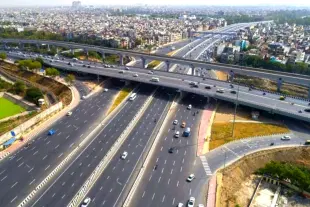Infrastructure
Roadmap 2047: Government Drafts Ambitious Master Plan For Expressway Expansion
V Bhagya Subhashini
Mar 22, 2024, 01:37 PM | Updated 01:35 PM IST
Save & read from anywhere!
Bookmark stories for easy access on any device or the Swarajya app.


The government is drafting a national master plan for highway and expressway development by 2047, aiming to double daily coverage of trucks to 800 km.
The envisioned plan is poised to revolutionise the transportation sector by introducing expressways and modern highways, facilitating an increase in speed that promises to slash logistics costs by an estimated 3-4 per cent.
This revelation comes in the wake of a recent study conducted by the National Council of Applied Economic Research (NCAER), in collaboration with the Asian Development Bank (ADB) and industry experts, which highlighted that logistics expenses in India account for approximately 7.8 per cent to 8.9 per cent of the nation's total economic output.
Currently, trucking operations in India lag far behind global standards, with vehicles covering only 300-350 km per day, significantly less than their counterparts in the US and Europe.
The stark comparison reveals that in Europe, trucks can travel up to 750 km a day, while in the US, drivers are legally permitted to cover distances ranging from 1,100 to 1,200 km daily, cruising at speeds of 100 km/hour, reports Financial Express.
In a bid to enhance logistical efficiency, the government had earlier unveiled a comprehensive logistics policy in September 2023, with the overarching goal of aligning India's logistical costs with global benchmarks by 2030.
This strategic initiative aims to elevate India's ranking in the World Bank’s Logistics Performance Index (LPI), positioning the nation among the top 25 countries by the end of the decade, while also establishing a data-driven decision support mechanism to bolster the efficiency of the logistics ecosystem.
Notably, India's progress in the realm of logistics has already been recognised by the World Bank, which elevated the country's ranking to 38 out of 139 nations in its latest LPI rankings for 2023, marking a significant improvement from its 2018 ranking.
The national master plan, a cornerstone of the broader Vision 2047 spearheaded by the Ministry of Road Transport and Highways, envisages the construction of 50,000 km of access-controlled highways.
These expressways will be strategically positioned to ensure accessibility from any point in the country within a range of just 100-125 km, thereby enhancing connectivity and efficiency.
Furthermore, alongside the development of greenfield expressways, the government is committed to augmenting the capacity of existing highways. Noteworthy progress has already been made, with the share of highways with less than two lanes shrinking to a mere 10 per cent in 2023 from 30 per cent in 2014.
Meanwhile, the length of highways boasting two lanes or more but less than four lanes has surged to 58 per cent, encompassing a total of 85,096 km. Similarly, highways featuring four lanes or more now span 46,179 km, constituting 32 per cent of the total length, a significant leap from 20 per cent in 2014.
The proposed unveiling of the national master plan marks a pivotal moment in India's journey towards modernising its transportation infrastructure, with far-reaching implications for economic growth, connectivity, and efficiency on a national scale.
V Bhagya Subhashini is a staff writer at Swarajya. She tracks infrastructure developments.





